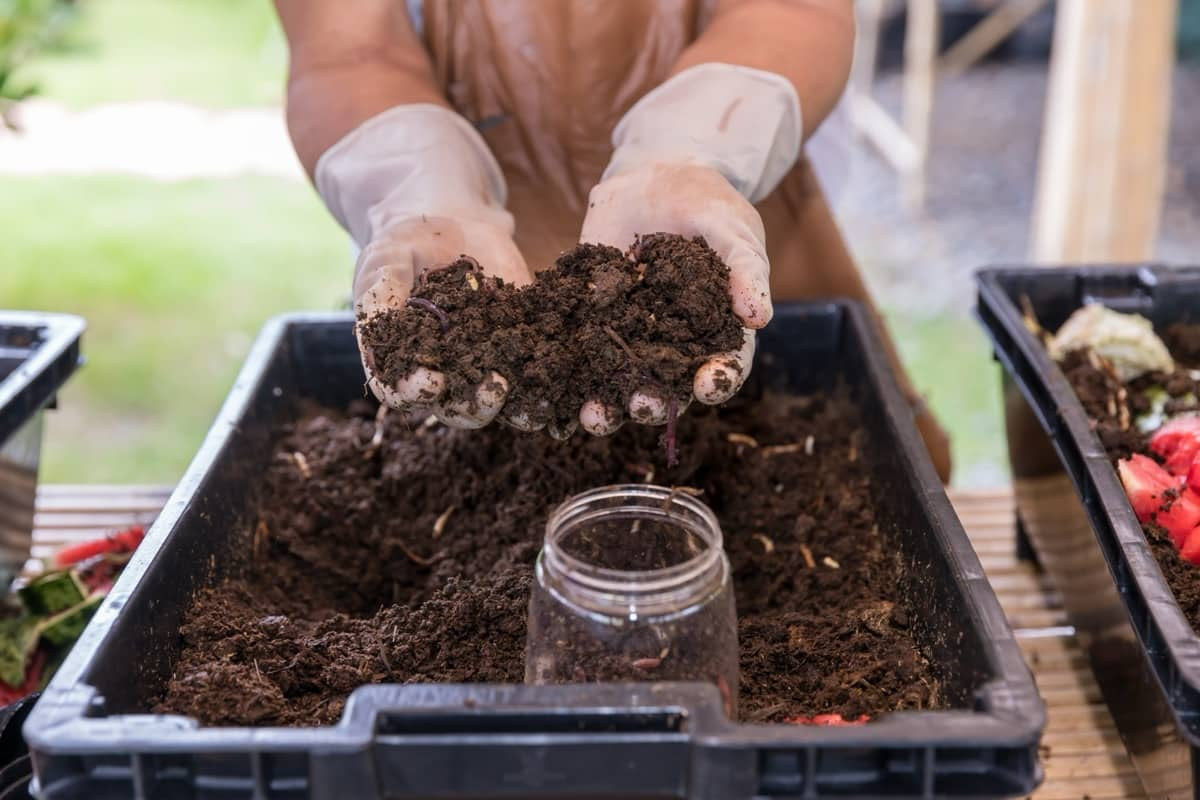Fertilizing potted custard apple trees is essential to ensure their optimal growth and fruit production. Whether you prefer organic, natural, or homemade options, understanding the basics of fertilization is crucial. This guide will explore various fertilization methods, NPK ratios, and when and how to apply them to keep your custard apple trees thriving in containers.

Fertilizing Potted Custard Apple Trees
Organic Fertilizers for Custard Apple Trees in Pots: Nurturing Your Trees Naturally
Organic fertilizers are a sustainable choice for nurturing custard apple trees in pots. They promote soil health and minimize environmental impact. Choose compost, well-rotted manure, or organic granular fertilizers with a balanced NPK ratio (e.g., 5-5-5). Apply these fertilizers in early spring and late summer, following package instructions.
Organic options release nutrients slowly, providing long-term benefits to your potted trees. Be cautious not to over-fertilize, as it can harm your trees. Regularly monitor soil moisture and pH levels to ensure your custard apple trees naturally receive the nutrition they need.
Natural Fertilizers for Custard Apple Trees in Pots: for Environmentally-friendly Options
Natural fertilizers offer environmentally friendly options for nurturing custard apple trees in pots. Consider using compost tea, fish emulsion, or seaweed extract. These products are derived from renewable sources and provide essential nutrients without synthetic chemicals. Their NPK ratios vary, so choose one that suits your tree’s needs and follow application instructions.
Apply these natural fertilizers during the growing season, typically spring and summer, to support healthy growth and fruit development. Remember to water your potted trees before and after fertilizing to prevent root burn. By opting for natural fertilizers, you promote your tree’s well-being and contribute to a sustainable and eco-friendly gardening approach.
Homemade Fertilizers for Custard Apple Trees in Pots: DIY Solutions for Optimal Plant Health
Creating homemade fertilizers for your potted custard apple trees can be a cost-effective and rewarding way to enhance their health. Consider making compost tea, banana peel fertilizer, or eggshell powder. To apply these DIY fertilizers, dilute them in water and feed your trees during the growing season.
Maintain proper moisture levels to prevent nutrient leaching. Homemade fertilizers supply essential nutrients, reduce waste, and recycle kitchen leftovers. By customizing your fertilizers, you can cater to your custard apple tree’s specific requirements, ensuring they thrive in their potted environment while staying eco-friendly.
NPK Ratios and Their Importance in Selecting Fertilizers for Custard Apple Trees in Pots
NPK ratios are crucial in selecting the right fertilizers for potted custard apple trees. NPK refers to the three essential nutrients: nitrogen (N), phosphorus (P), and potassium (K). Different stages of a custard apple tree’s growth require varying ratios. For instance, a balanced NPK ratio like 10-10-10 is suitable for overall tree health, but a higher phosphorus ratio (e.g., 5-10-10) is beneficial during flowering and fruiting phases.
In case you missed it: How to Pollinate Custard Apple Trees: Hand Pollination, Natural Pollination Methods, and Tips

Nitrogen encourages leafy growth, phosphorus aids root development, and potassium supports fruit production. Understanding your tree’s growth stage and its nutrient needs helps you choose the right fertilizer to ensure optimal growth and fruit yield in potted custard apple trees.
Slow-release Fertilizers: Enhancing Nutrient Availability for Custard Apple Trees in Pots
Slow-release fertilizers are a valuable choice for potted custard apple trees. These fertilizers gradually release nutrients over an extended period, providing a consistent and steady supply for your trees. Slow-release granules or pellets are applied to the soil’s surface and break down slowly, reducing the risk of over-fertilization and nutrient leaching. They improve nutrient availability to the roots and decrease the need for frequent reapplication. Choose a slow-release option with a tailored NPK ratio to meet your custard apple tree’s specific growth stage and ensure sustained long-term nourishment.
pH Levels and Fertilizer Selection for Custard Apple Trees in Pots: For Balanced Soil Environment
pH levels significantly impact your custard apple tree’s nutrient uptake and overall health. These trees thrive in slightly acidic to neutral soil, with a pH range between 6.0 to 7.0. Maintaining the right pH is crucial, as it influences nutrient availability. If the soil is too acidic (low pH), certain nutrients become less accessible to the tree, leading to deficiencies.
Conversely, nutrient uptake may also be compromised if the soil is too alkaline (high pH). When selecting fertilizers for potted custard apple trees, consider their impact on pH levels. Organic materials like compost acidify the soil slightly, making it suitable for custard apples. In contrast, some synthetic fertilizers may increase soil alkalinity.
The Importance of Timing: When to Apply Fertilizer to Custard Apple Trees in Pots
Proper timing ensures that your trees receive nutrients when they need them most. For potted custard apple trees, the ideal timing for fertilizer application is during the growing season, typically in spring and early summer. This period corresponds to the tree’s active growth phase. Avoid fertilizing during winter, as the tree’s nutrient requirements are minimal. Similarly, refrain from fertilizing too late in the growing season, as it can promote late-season growth that may be vulnerable to cold weather.
Splitting the total fertilizer dose into two or three applications throughout the growing season is generally beneficial. Apply the first dose in early spring as the tree awakens from dormancy, and follow up with subsequent applications every 6-8 weeks until early summer. This gradual approach helps prevent over-fertilization and supports steady, healthy growth in your potted custard apple trees.
In case you missed it: Project Report of 1-Acre Custard Apple Farming: Cultivation Cost and Profit Analysis

How to Apply Fertilizer to Custard Apple Trees in Pots: Techniques for Maximum Effectiveness
- Measure: Determine the correct dosage based on your tree’s size and the manufacturer’s recommendations.
- Surface Application: Sprinkle the fertilizer evenly on the soil surface around the tree, avoiding direct contact with the trunk. Ensure even distribution to prevent localized nutrient imbalances.
- Watering: After applying the fertilizer, thoroughly water the soil to help the nutrients penetrate the root zone. This also prevents the risk of root burn.
- Mulching: Apply a layer of organic mulch (e.g., wood chips or straw) around the tree. Mulch helps retain soil moisture and regulates temperature, enhancing the fertilizer’s effectiveness.
- Regular Monitoring: Keep an eye on your tree’s growth and overall health. Adjust your fertilization schedule if needed based on the tree’s response and any changes in soil conditions.
Water-soluble Fertilizers for Potted Custard Apple Trees
- Mixing: Follow the manufacturer’s instructions to mix the water-soluble fertilizer with water at the recommended concentration. Use a measuring container to ensure accuracy.
- Frequency: Apply water-soluble fertilizer every 2-4 weeks during the growing season, starting early spring and continuing through early summer. This frequent application provides a steady supply of nutrients.
- Application: Pour the diluted fertilizer solution evenly around the base of your custard apple tree, avoiding direct contact with the trunk. Water the tree immediately after application to help the nutrients reach the roots.
- Monitoring: Monitor your tree’s growth and leaf color for nutrient needs. Adjust the frequency of fertilizer applications if necessary.
Table for Fertilizing Potted Custard Apple Trees: Organic, Natural, Homemade, NPK Ratio And When to Apply
| Type of Fertilizer | Fertilizer | When to Apply |
| Organic | Compost, Manure | Before Planting or During spring/summer |
| Natural | Epsom salt, Compost Tea | As side dressing in spring/summer |
| Homemade | Banana Peels, Eggshells | As side dressing in spring/summer |
| NPK ratio | 10-10-10 or 5-10-10 | 2-3 splits per season |
| Water soluble | Blood meal, Seaweed Extract | During growing season |
| Slow release | As spikes available in the market | During growing season |
In case you missed it: 9 Causes of Dying Custard Apple Tree and How to Fix It?

Conclusion
Fertilizing potted custard apple trees is a vital aspect of their care. Whether you opt for organic, natural, or homemade fertilizers, understanding NPK ratios, proper timing, and application techniques is key. You can nurture healthy and fruitful custard apple trees in pots by catering to their specific needs and maintaining balanced soil conditions.
- Ultimate Guide to Ossabaw Island Hog: Breeding, Raising, Diet, and Care
- Ultimate Guide to Juliana Pig: Raising Facts, Size, Diet, Care, and Lifespan
- Raising Lleyn Sheep: Disadvantages, Price, Uses, Characteristics, and Care
- Ultimate Guide to Meishan Pig: Breed Facts, Breeding, Raising, and Care
- Ultimate Guide to Teacup Pigs: Raising, Diet, Lifespan, Cost, and Care
- Guide to Raising Poll Dorset Sheep: Facts, Profile, Characteristics, Uses, and Care
- Ultimate Guide to Bighorn Sheep: Characteristics, Diet, Lifespan, Breeding, and Lifecycle
- Ultimate Guide to Raising Katahdin Sheep: Farming Facts, Breed Profile, Uses, and Care
- Ultimate Guide to Raising Oreo Cows: Belted Galloways Farming Facts, Profile, Uses, and Care